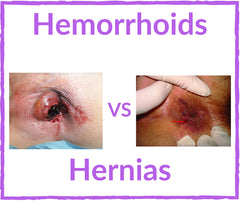Hernia vs Hemorrhoids Guide - Do I Have A Hernia or Hemorrhoids Discover the Truth?
Posted on 24 July 2018 by Maryanne Johnson
Share this post
In this hernia vs hemorrhoids guide, we will look at the differences between hemorrhoids and hernias so you can figure out which one you have. A painful bulge can mean a hernia or hemorrhoid, but while both conditions look similar in some cases, they are inherently different. How do you know which one you have?
It is essential to know the basics of both conditions to understand and diagnose the problem at hand. There are several types of hernias, and there are only two types of hemorrhoids.
Hernias are when an internal organ or tissue protrudes through an area of the body where the muscles are weak or have an opening. Straining and muscle weakness are contributing factors behind hernias, and some people are more prone to getting them than others.
Types of hernias include:
- Inguinal: a hernia that is found in the groin and is the most commonly occurring type of a hernia
- Congenital diaphragmatic: a hernia that arises from congenital disability, requiring surgery
- Hiatal: a hiatal hernia is when the upper portion of your stomach bulges through an opening in the diaphragm, frequently resulting in gastroesophageal reflux disease
- Incisional: a hernia that protrudes through a scar
- Umbilical: a hernia that occurs around the belly button
Hernias are common and can occur in any group of people—men, women, and children. Hernias are mostly found in men over 40, but people with predisposed muscle weakness are more prone to getting hernias.
Alternatively, hemorrhoids are sacs of blood vessels that have become swollen clusters due to pressure placed on them, or from being overtaxed from a hard-to-pass bowel movement.
Types of hemorrhoids are:
- Internal: the veins and vessels located inside the lowest part of the rectum that has become swollen and inflamed
- External: a cluster of blood vessels and rectal veins under the skin's surface, outside of the anus
Hernia & Hemorrhoids Youtube Video Guide
Internal hemorrhoids cannot be seen or felt. They are rated in varying degrees or grades, indicating if the internal hemorrhoid has fallen out of the rectum, and if so, what stage of prolapse is it in.
External hemorrhoids are visible bulges around the anus. They hurt and ache, and can also itch and become irritated easily, especially when moving, or remain in a particular position for long periods of time.
If any of the two types of hemorrhoids is confused with a hernia, it is an external hemorrhoid.
The coloring of these protruding sacs may be similar in appearance. External hemorrhoids and hernias located in the groin area are equally common.
Like hernias, hemorrhoids can form because the veins in the lower rectum are overworked or have faced excessive pressure.
Typically, this is due to a few common factors of age, diet, if the person is pregnant or postpartum, or if he or she lifts heavy objects frequently.
How Can You Tell the Difference Between a Hemorrhoid and a Hernia?
Swollen, protruding lumps that are uncomfortable and painful can either mean you have a hernia or hemorrhoids. Hernias are common in the lower abdominal wall area and can be confused with hemorrhoids, which occur in the rectal area.
These two conditions are diversely different. A hernia is a bulge that contains tissues or internal organs that has found its way through the weakened area of the muscle wall. Hernias are flesh colored or reddened.
Hemorrhoids only occur around the anus or inside the rectum. Unlike a hernia, they are not sacs of internal organs, but rather a collection of blood vessels, connective tissues from the anal canal, and smooth rectal muscles.
Hernias may also move as digestion occurs. This slight movement is attributed to the face that hernias consist of parts of an internal organ that has been forced through the muscles, creating a visible, protruding lump.
Hernias are not as hard of a lump as hemorrhoids, because inside, they contain the soft internal organs that have found their way through the barrier of muscle. If you have a hernia, you might only notice it when you jump, cough, or strain.
Hemorrhoids are harder lumps that only form on the anus or around it. They are felt all of the time because they are painful and sensitive. A hemorrhoid may hinder the quality of your life, even making sitting or standing uncomfortable.
If you cannot tell whether or not you have a hernia or are experiencing hemorrhoids, you should always ask your doctor. Your doctor has seen both conditions and with you describing the various symptoms or by executing an examination, will be able to tell right away whether you have a hernia or hemorrhoids.
Your age, gender, lifestyle, and family history will also help guide your doctor in making a correct diagnosis of a hemorrhoid or a hernia. These factors can shed light on the likelihood of either condition.
Can a Hernia Cause a Hemorrhoid?
Hernias and hemorrhoids are two separate, distinct conditions and one does not cause another. Hernias and hemorrhoids can be confused with one another due to their similarities, but there are enough differences to set them apart regarding a diagnosis.
However, hernias and hemorrhoids may occur due to similar issues.
Excessive pushing and struggling to pass stools is a contributing aggravator for both hernias and hemorrhoids.
Hernias arise because a part of an internal organ is pushed through weak muscle tissues, and the force behind this cause can come from attempting to pass hardened stools.
In contrast, hemorrhoids form when the rectal veins, soft tissues, blood vessels, and smooth muscles are overworked and become inflamed.
Externally, you may see small bumps that hurt when touched or while moving, sitting, or standing.
Of course, these lumps that are located outside of the rectum may look and feel similar. Hemorrhoids, however, are itchier than a hernia. Internal hemorrhoids also produce bright red blood after a bowel movement.
Hemorrhoids cannot cause hernias, either, but a person is more likely to have hemorrhoids and hernias if it runs in their family.
Genetics plays an overpowering role in the conditions we develop, either early on, or later in adulthood, like hernias and hemorrhoids.
The Hernia and Hemorrhoid Connection
Hernias and hemorrhoid worsen and form when straining is involved. For hernias, this can further push the part of the internal organ outward, making the lump more noticeable externally.
A hernia is a soft lump of an internal organ, and for mild cases, a doctor can massage it back into place.
Treatment could be held off on a small and soft hernia, with your doctor monitoring it for any changes or new symptoms, like pain.
Hemorrhoids and hemorrhoidal symptoms worsen when straining occurs.
For hemorrhoids, the inflammation is a direct correlation to poor toilet habits that involve issues like low fiber that leads to constipation, chronic diarrhea, and hard, abrasive stools.
Stools that lack moisture are more challenging to pass, and sometimes they can scrape against the interior rectal lining, resulting in inflamed internal and rectal bleeding hemorrhoids.
In either case of a hemorrhoid or a hernia, a description of the symptoms should be reported to your doctor immediately.
When caught early on, hernias and hemorrhoids can be treated with non-aggressive methods.
Hernias that are small enough do not require surgery as a resolution.
Hemorrhoids in their milder form can be treated with over the counter topical creams that target inflammation and swelling of this cluster of rectal veins, vessels, and tissues.
What is a Thrombosed Hernia?
When something is "thrombosed," it means that a blood clot has taken shape. A thrombosed hernia refers to a blood clot forming inside of the hernia.
Hernias are already a painful condition, so when there is a presence of a blood clot inside of a hernia protrusion, the pain becomes even more amplified.
A hernia may become bluish in color, and when touched, you will feel a sharp, lingering pain.
This instance should be reported to your doctor right away. You don’t want a thrombosed hernia to rupture and put yourself at risk for an infection to arise in the open wound.
You also don’t want to have live with such a painful hernia and blood clot, because you will immediately notice how limiting it is.
Hemorrhoids can become thrombosed, too. A thrombosed hemorrhoid is considered a complication, and like a thrombosed hernia, should be treated by your doctor right away.





0 comments